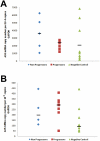Expression of APOBEC3G/3F and G-to-A hypermutation levels in HIV-1-infected children with different profiles of disease progression
- PMID: 21897871
- PMCID: PMC3163681
- DOI: 10.1371/journal.pone.0024118
Expression of APOBEC3G/3F and G-to-A hypermutation levels in HIV-1-infected children with different profiles of disease progression
Abstract
Objective: Increasing evidence has accumulated showing the role of APOBEC3G (A3G) and 3F (A3F) in the control of HIV-1 replication and disease progression in humans. However, very few studies have been conducted in HIV-infected children. Here, we analyzed the levels of A3G and A3F expression and induced G-to-A hypermutation in a group of children with distinct profiles of disease progression.
Methodology/principal findings: Perinatally HIV-infected children were classified as progressors or long-term non-progressors according to criteria based on HIV viral load and CD4 T-cell counts over time. A group of uninfected control children were also enrolled in the study. PBMC proviral DNA was assessed for G-to-A hypermutation, whereas A3G and A3F mRNA were isolated and quantified through TaqMan® real-time PCR. No correlation was observed between disease progression and A3G/A3F expression or hypermutation levels. Although all children analyzed showed higher expression levels of A3G compared to A3F (an average fold of 5 times), a surprisingly high A3F-related hypermutation rate was evidenced in the cohort, irrespective of the child's disease progression profile.
Conclusion: Our results contribute to the current controversy as to whether HIV disease progression is related to A3G/A3F enzymatic activity. To our knowledge, this is the first study analyzing A3G/F expression in HIV-infected children, and it may pave the way to a better understanding of the host factors governing HIV disease in the pediatric setting.
Conflict of interest statement
Figures




References
-
- Foster C, Waelbrouck A, Peltier A. Adolescents and HIV infection. Curr Opin HIV AIDS. 2007;2:431–436. - PubMed
-
- Abrams EJ, Wiener J, Carter R, Kuhn L, Palumbo P, et al. Maternal health factors and early pediatric antiretroviral therapy influence the rate of perinatal HIV-1 disease progression in children. Aids. 2003;17:867–877. - PubMed
-
- Alexander L, Cuchura L, Simpson BJ, Andiman WA. Virologic and host characteristics of human immunodeficiency virus type 1-infected pediatric long term survivors. Pediatr Infect Dis J. 2006;25:135–141. - PubMed
-
- Harris RS, Bishop KN, Sheehy AM, Craig HM, Petersen-Mahrt SK, et al. DNA deamination mediates innate immunity to retroviral infection. Cell. 2003;113:803–809. - PubMed
-
- Mariani R, Chen D, Schrofelbauer B, Navarro F, Konig R, et al. Species-specific exclusion of APOBEC3G from HIV-1 virions by Vif. Cell. 2003;114:21–31. - PubMed
Publication types
MeSH terms
Substances
LinkOut - more resources
Full Text Sources
Medical
Molecular Biology Databases
Research Materials

